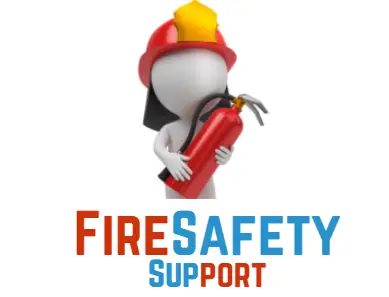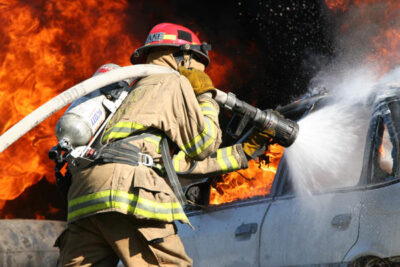The uniqueness of firefighters is that they are the first ones on the scene of an emergency. They are not only trained in firefighting but also in life-saving techniques so that they can get to anyone who needs help. Also, there are different types of firefighters, and we will discuss them with their roles on this page.
Firefighter is a general name, but there are different types, such as volunteer, inspector, wildland, airport, engineer, investigator, and many more. Also, there are ranks in this profession, and you need to know them as well.
Just read further to discover the types and roles of firefighters below.
What does a firefighter do?
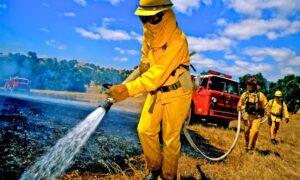
A firefighter is someone who fights fires. They can be called to battle blazes, or they could be called in to deal with a car accident that has caught fire. They are trained to work in teams and can put out fires when they happen, but they also have to train themselves to know how to handle dangerous situations as well.
Also, they are trained in many areas and are expected to be able to do anything that their jobs require. Training includes things like CPR and first aid, but they also learn about topics like fire safety and building codes. Because of this, many firefighters have college degrees or other training in subjects like science or engineering.
The job of a firefighter is to put out fires, save lives, and prevent injuries or damage to property. A firefighter’s training and experience as a first responder are invaluable when it comes to tackling emergencies like fires, car crashes, and medical emergencies.
Firefighters work in teams of two or three people, and each member has specific tasks they need to accomplish during an emergency:
- Pulling victims from vehicles
- Extinguishing fires
- Searching for survivors in collapsed buildings
- Using special equipment to locate people trapped under debris or collapsed floors
Read:: Best Firefighting Movies
8 Types of firefighters
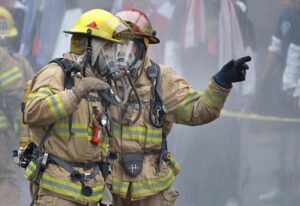
There are several different types of firefighters. Each type has its own job and responsibilities, but all of them work together to keep people safe and property damage at a minimum. Here’s what you need to know about each type of firefighter:
1. Volunteer firefighter
Volunteer firefighters are part of a volunteer fire department, and they perform a number of duties.
The primary duty of a volunteer firefighter is to keep the fire department up-to-date on all emergencies and other incidents. They also often provide emergency medical care for those in need, such as when someone has been hurt in an accident or during an emergency response.
Volunteer firefighters must also be able to respond quickly to any calls that come in, which may include fires, medical emergencies, or natural disasters like earthquakes or floods. They need to be able to perform this duty while on their own time and not at work (i.e., after hours).
They may also participate in training exercises with their colleagues at the fire department as this helps them understand each other’s jobs better so they can work together more effectively when they’re needed most during an emergency situation or natural disaster response effort.
2. Inspector
Inspector firefighters are the highest-ranking members of their fire department. They have a great deal of responsibility and should be held to a very high standard.
They investigate fires, accidents, and other emergencies in the city. They are responsible for ensuring that all of the city’s fire departments are operating at peak efficiency and making sure that regulations are being followed.
Also, inspectors’ firefighters must be physically fit and able to take tough calls from citizens. They must be able to think on their feet and make quick decisions in stressful situations.
3. Wildland firefighter
Wildland firefighters are the first responders to wildfires, natural disasters, and other emergencies. They are trained in firefighting, rescue, and wildland fire prevention. They have specialized equipment, including fire shelters and breathing apparatus.
Wildland firefighters work in teams of five or more people who specialize in a particular area of the country. And their role or duties is to:
Responding to fires, evacuations, and other emergencies
Assisting local law enforcement agencies with search and rescue operations
Providing technical advice to firefighting professionals at all levels of government
Conducting research in areas such as fuels management, wildland fire behavior, fuel mapping techniques, and many more.
4. Firefighter engineer
A firefighter engineer is a person who designs, builds, and maintains firefighting equipment for a fire department.
Firefighter engineers are responsible for ensuring that the equipment they design will work as intended. They must also be able to troubleshoot and repair damaged equipment.
They need to be able to understand how different parts of the firefighting system work together, including how it communicates with other parts of the system.
So to be a firefighter engineer, you must have an understanding of basic science and math concepts such as geometry, trigonometry, and physics.
5. Airport firefighter
Airport firefighters are responsible for the safety and security of aircraft, airports, and property. They are trained to respond quickly and efficiently during emergencies, such as fires or other disasters.
Also, airport firefighters work throughout the airport complex or on a single airport facility at a time. Their duties include:
- Responding to emergencies
- Preventing and fighting fires
- Escorting aircraft with passengers on board
- Locating missing people
6. Firefighter/EMT
Firefighters and EMTs are responsible for helping people in need, while they are also expected to prevent fires and other emergencies. They must be able to perform their duties safely and effectively, as well as make sure that buildings are safe for residents.
They must be trained to do a variety of jobs, including fighting fires, rescuing people from burning buildings, fighting fires at sea or in the air, and even fighting fires in remote areas.
7. Firefighter/paramedic
Firefighters and paramedics are two different types of firefighters. Firefighters are the first line of defense in a fire or other emergency. They use specialized equipment to put out fires and rescue people who are trapped inside buildings or cars.
Though firefighters can use a variety of tools, including ladders, pumps, and breathing apparatuses, their most common mode of transport is an Engine truck.
Paramedics are medical professionals who provide emergency medical care to victims of accidents on highways or in hospitals.
They use a wide range of devices, such as defibrillators, suction devices, and oxygen masks, to help treat patients who have been injured in car crashes or fires.
8. Fire investigator
Fire investigators are responsible for investigating fires, accidents, and other incidents to determine the cause and assess the damage.
This can include the types of firefighters that responded to the incident, as well as any other relevant information about the event. Investigators may also be called upon to testify in court for cases where negligence is suspected.
Read: Thin Red Line Flag
What are the firefighter ranks?
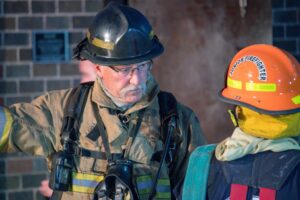
Firefighter ranks are a set of titles that a firefighter can earn as they work their way through the ranks of their department. These titles range from Lieutenant to Captain and are bestowed upon firefighters who have demonstrated leadership, dedication, and skill in the field of firefighting.
Below are some of the firefighter ranks that you need to know:
1. Probationary firefighter
The probationary firefighter is the lowest rank in the firefighter ranks. They are still considered firefighters, but they lack experience and training. Probationary firefighters are trained to perform duties as a firefighter in their own right but aren’t allowed to make critical decisions for themselves or their colleagues.
2. Firefighter I
This is the lowest rank in the fire service. Firefighters in this rank are trained to handle small fires, such as those involving a candle or cigarette lighter. They also help with basic rescues and emergency medical services.
3. Firefighter II
This rank is for people who have previous experience as firefighters. They may have worked at a fire station or been an emergency responder before becoming firefighter II, but they’re still not qualified to fight fires on their own after training.
Firefighters IIs do not receive any special training for fighting fires or fighting disasters; however, they can assist other firefighters during emergencies by performing tasks such as directing traffic away from dangerous situations or providing first aid to injured people.
4. Firefighter III
The third-ranking position in the fire service is reserved for people who have received specialized training in fighting fires and disaster response, though they will still be considered only “qualified” individuals when it comes to fighting fires themselves.
5. Chief Officer
The Chief Officer is in charge of the unit and makes decisions about its operations. He or she is responsible for teaching new recruits, assigning duties, and training firefighters on their duties.
6. Captain
A Captain has more experience than a Chief Officer but is not as senior as a Division Chief. Captains are assigned to lead other firefighters, including probationary firefighters and other captains.
7. Lieutenant
Lieutenants have more experience than Captains but less than Commanders. Lieutenants oversee other Lieutenants and Fire Marshals.
8. Sergeant
The Sergeant oversees other Squads, Inspectors, and Fire Marshals; they also assist Commanders in training new recruits, prepare briefing notes for Battalion Chiefs and prepare fire equipment reports for Station Chiefs.
9. Fire Marshal
The Fire Marshal conducts investigations into fires; they also act as liaisons between departments when there are questions about each other’s activities or safety measures during an emergency response incident such as an earthquake or tornado outbreak (tornado watch).
Read:: Do Volunteer Firefighters Get Paid?
Conclusion
Firefighters are important for a number of reasons. First, they are the first responders to fires and emergencies, and there are different types of firefighters which you can learn on this page.
When you call 911, the firefighters arrive as soon as possible and save lives. They also help to make sure that buildings are safe by inspecting them for fire hazards and making repairs where necessary. Firefighters also respond to medical emergencies, such as car accidents or heart attacks.
